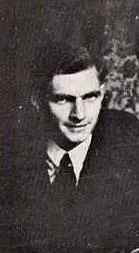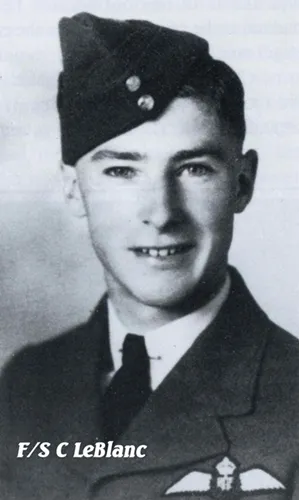Winkler, Eric Alfred (Warrant Officer 2)
Prisoner of War 1942-June-17
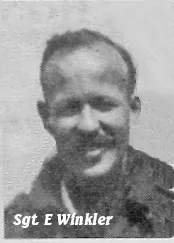

Birth Date: unkown date
Born:
Parents:
Spouse:
Home: Hanover, Ontario
Enlistment:
Enlistment Date: unkown date
Service
RCAF
Unit
419 (B) Sqn- Squadron
Moosa Aswayita Beware of Moose
Base
RAF Mildenhall
Rank
Warrant Officer 2
Position
Wireless Operator/Air Gunner
Service Numbers
R/71755
PoW: 366
Home
Target
Crew or Other Personnel
Wellington X3359
Mission
Wellington Mk. III X3359
Bombing Essen Germany 1942-June-16 to 1942-June-17
419 (B) Sqn (RCAF) RAF Mildenhall
106 aircraft - 40 Wellingtons, 39 Halifaxes, 15 Lancasters, 12 Stirlings. 8 aircraft¬I lullfaxes, 3 Wellingtons, 1 Stirling - lost
.Only 16 crews reported that they had identified Essen; 56 bombed alternative targets, 45 of them attacking Bonn. Essen reports only 3 high-explosive and 400 incendiary bombs in the city with one person being wounded
.This raid concluded the present series of 5 raids on Essen in 16 nights. 1607 sorties had been dispatched and 84 aircraft (5·2 per cent) lost. No industrial damage was caused in Essen on any of these raids; a few houses were destroyed and 38 civilians were killed. Bomber Command now temporarily abandoned its campaign against Essen which would not be visited in strength for 3 months. /p>
source: The Bomber Command War Diaries, Martin Middlebrook and Chris Everitt
419 Moose Squadron (Moosa Aswayita) RAF Mildenhall. Wellington III aircraft X 3359 VR-N had the starboard engine fail and the pilot was forced to jettison the bomb load in an attempt to maintain altitude and return to base during an operation to Essen, Germany. The aircraft could not get above 3,000 feet and fell victim to the heavily defended city of Antwerp, Belgium. The pilot, FS CE LeBlanc (RCAF), maintained control of the aircraft long enough for his crew to bail out, he waited too long and went down with the aircraft, killed in action
Two of the crew, Sergeant EA Winkler (RCAF) and Sergeant NW Bradley (RCAF), survived and were taken as Prisoners Of War
The other two crew members Pilot Officer JH Watson (RCAF) and Sergeant Angers MiD (RCAF) survived, evaded capture and were returned safely to England
Wellington serial: X3359
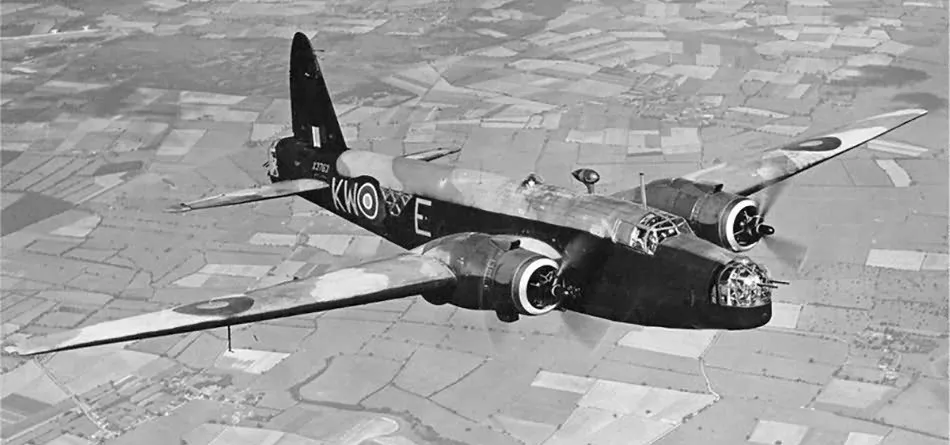
Vickers Wellington B. Mk. III (Serial No. X3763), coded KW-E, No. 425 'Alouette' (B) Squadron, RCAF, late summer of 1942
The Vickers Wellington was a British twin-engined, long-range medium bomber. It was designed during the mid-1930s at Brooklands in Weybridge, Surrey. Led by Vickers-Armstrongs' chief designer Rex Pierson, a key feature of the aircraft is its geodetic airframe fuselage structure, which was principally designed by Barnes Wallis. Development had been started in response to Air Ministry Specification B.9/32, issued in the middle of 1932, for a bomber for the Royal Air Force. This specification called for a twin-engined day bomber capable of delivering higher performance than any previous design.
The Wellington was used as a night bomber in the early years of the Second World War, performing as one of the principal bombers used by Bomber Command. During 1943, it started to be superseded as a bomber by the larger four-engined "heavies" such as the Avro Lancaster. The Wellington continued to serve throughout the war in other duties, particularly as an anti-submarine aircraft.
It holds the distinction of having been the only British bomber that was produced for the duration of the war, and of having been produced in a greater quantity than any other British-built bomber. The Wellington remained as first-line equipment when the war ended, although it had been increasingly relegated to secondary roles. The Wellington was one of two bombers named after Arthur Wellesley, 1st Duke of Wellington, the other being the Vickers Wellesley.
In August 1936, an initial order for 180 Wellington Mk I aircraft, powered by a pair of 1,050 hp (780 kW) Bristol Pegasus radial engines, was received by Vickers; it had been placed so rapidly that the order occurred prior to the first meeting intended to decide the details of the production aircraft. In October 1937, another order for a further 100 Wellington Mk Is, produced by the Gloster Aircraft Company, was issued; it was followed by an order for 100 Wellington Mk II aircraft with Rolls-Royce Merlin X V12 engines. Yet another order was placed for 64 Wellingtons produced by Armstrong Whitworth Aircraft. With this flurry of order and production having been assured by the end of 1937, Vickers set about simplifying the manufacturing process of the aircraft and announced a target of building one Wellington per day.
A total of 180 Wellington Mk I aircraft were built; 150 for the RAF and 30 for the Royal New Zealand Air Force (RNZAF) (which were transferred to the RAF on the outbreak of war and used by 75 Squadron). In October 1938, the Mk I entered service with 9 Squadron. The Wellington was initially outnumbered by the Handley Page Hampden (also ordered by the Ministry to B.9/32) and the Armstrong Whitworth Whitley (to B.34/3 for a 'night' bomber) but outlasted both rival aircraft in service. The Wellington went on to be built in 16 separate variants, in addition to two training conversions after the war. The number of Wellingtons built totalled 11,462 of all versions, a greater quantity produced than any other British bomber. On 13 October 1945, the last Wellington to be produced rolled out. Wikipedia
Unit Desciption
419 (B) Sqn Moosa Aswayita ("Moose")
History of the Squadron during World War II (Aircraft: Wellington IC, III, Halifax II, Lancaster X)
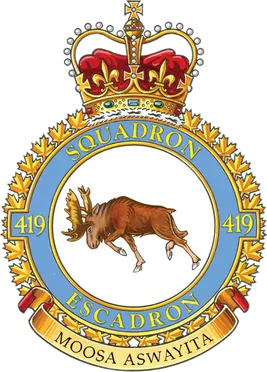
419 (Bomber) Squadron formed at RAF Mildenhall, Suffolk, UK  in 1941 as part of No 3 Group of Bomber Command. It got its name from its first commanding officer, Wing Commander John "Moose" Fulton, DSO, DFC, AFC. The squadron operated Vickers Wellington, then Handley Page Halifax and finally Avro Lancaster bombers through the course of WWII, with the squadron code letters VR. It was the third RCAF bomber unit to be formed in England. It started operations in January 1942, converting almost immediately from Wellington Mk ICs to Wellington Mk IIIs and then moving north to Leeming, Yorkshire,
in 1941 as part of No 3 Group of Bomber Command. It got its name from its first commanding officer, Wing Commander John "Moose" Fulton, DSO, DFC, AFC. The squadron operated Vickers Wellington, then Handley Page Halifax and finally Avro Lancaster bombers through the course of WWII, with the squadron code letters VR. It was the third RCAF bomber unit to be formed in England. It started operations in January 1942, converting almost immediately from Wellington Mk ICs to Wellington Mk IIIs and then moving north to Leeming, Yorkshire,  as part of 4 Group Bomber Command in August 1942. After short stays at Topcliffe
as part of 4 Group Bomber Command in August 1942. After short stays at Topcliffe  and Croft
and Croft  , it moved to Middleton St. George, County Durham
, it moved to Middleton St. George, County Durham  in November 1942, from which it flew until the end of hostilities. Here in November 1942 it was re-equipped with Halifax Mk IIs, which it flew for the next 18 months on the night offensive against Germany. In January 1943 it joined the newly formed 6 (RCAF) Group of Bomber Command.
in November 1942, from which it flew until the end of hostilities. Here in November 1942 it was re-equipped with Halifax Mk IIs, which it flew for the next 18 months on the night offensive against Germany. In January 1943 it joined the newly formed 6 (RCAF) Group of Bomber Command.
In April 1944 the squadron began to convert to the Avro Lancaster Mk X, which was produced in Canada and flown across the Atlantic. The squadron remained continuously on the offensive until 25 April 1945, when it flew its last sortie. Squadron personnel flew a total of 4,325 operational sorties during the war from Mannheim to Nuremberg, Milan to Berlin and Munich to Hanover, inflicting heavy damage on the enemy. On completion of the war in Germany, the squadron was earmarked to become part of the proposed "Tiger Force" to continue the war against Japan. However, the Japanese surrender in August 1945 led to the disbandment of the squadron in at Yarmouth, Nova Scotia  September 1945.
September 1945.
As a result of its wartime record, 419 Squadron became one of the most decorated units under the RCAF during the war. Over a span of roughly three-and-a-quarter years it logged 400 operational missions (342 bombing missions, 53 mining excursions, 3 leaflet raids and 1 "spoof") involving 4,325 sorties. A total of one hundred and twenty nine aircraft were lost on these operations. Members of the squadron accumulated 1 VC, 4 DSO's, 1 MC, 150 DFC's, 3 bars to DFC, 1 CGM, 35 DFM's: the VC was awarded posthumously to Flight Sergeant Andrew Mynarski for his attempts to help a fellow crew member escape from their burning aircraft. Battle Honours were: English Channel and North Sea 1942-44, Baltic 1942-44, Fortress Europe 1942-44, France and Germany 1944-45, Biscay Ports 1942-44, Ruhr 1942-45, Berlin 1943-44, German Ports 1942-45, Normandy 1944, Rhine, Biscay 1942; 1944. Wikipedia, Kostenuk and Griffin
![]() Squadron History (Bomber Command Museum)
Squadron History (Bomber Command Museum)
Maps for Movements of 419 Squadron 1941-45
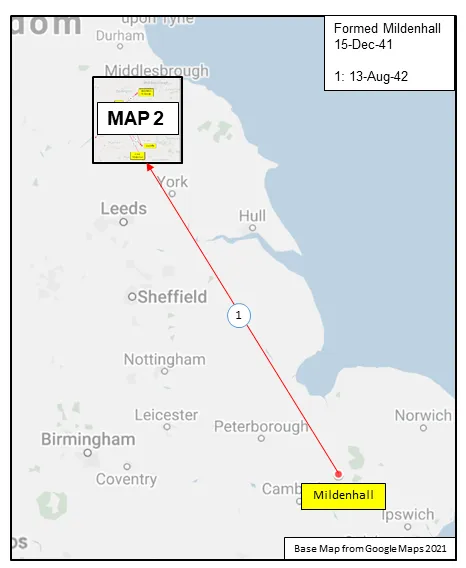
MAP 1: 419 Squadron Movements Dec 1941-Aug-42 (right-click on image to display enlarged new tab)
|
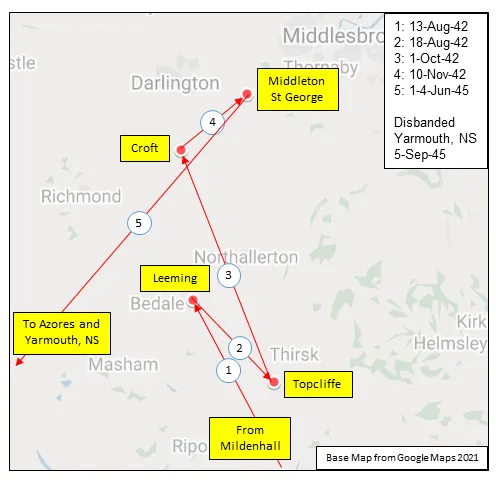
MAP 2: 419 Squadron Movements Aug 1942-Jun 1945
|
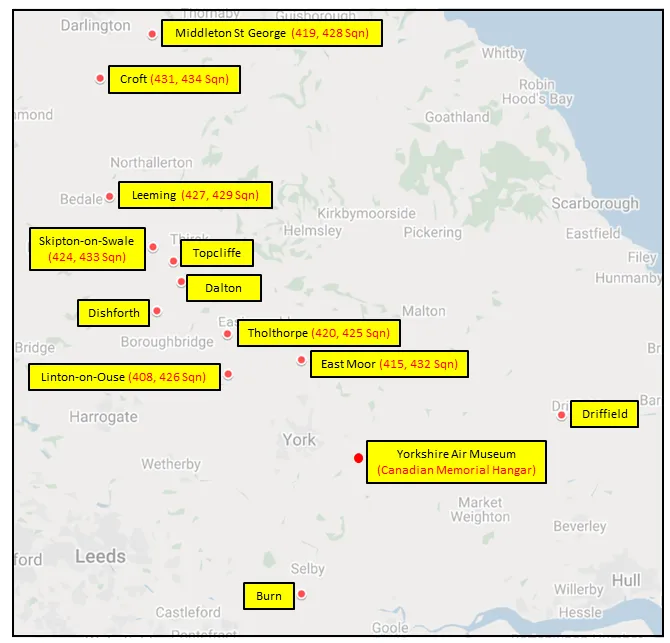
MAP 3: 6 Group Bomber Bases 1943-1945
|
419 Squadron History Summary 1941-45
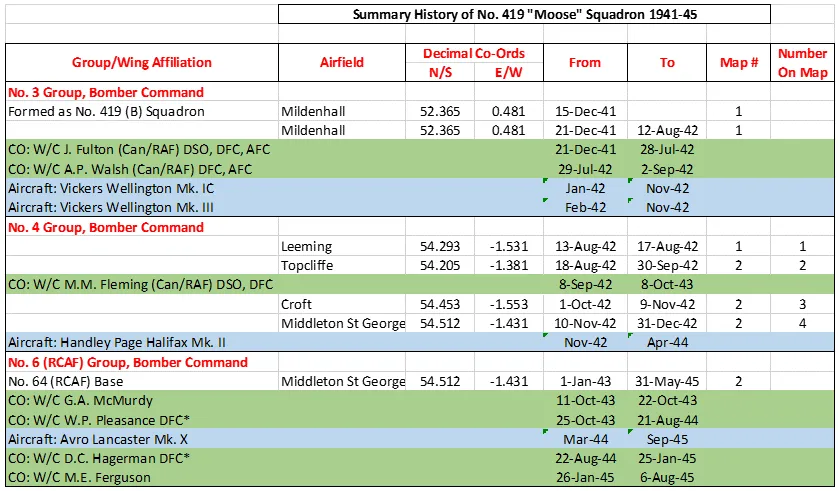
419 Squadron History Summary 1941-45 Page 2

History of the Squadron Post-WWII (Aircraft: Canuck, Silver Star, Freedom Fighter, Hornet)
The squadron was reactivated on 15 March 1954 at North Bay, Ontario  , as an all-weather fighter squadron flying the CF-100 Canuck. It moved to the NATO Air Division base at Baden-Soellingen, Germany
, as an all-weather fighter squadron flying the CF-100 Canuck. It moved to the NATO Air Division base at Baden-Soellingen, Germany  shortly after being formed. The squadron remained there until its disbandment in December 1962.
shortly after being formed. The squadron remained there until its disbandment in December 1962.
The squadron was again re-formed in December 1970, when it relocated to Cold Lake, Alberta  as No. 1 Canadian Forces Flight Training School. It initially flew the T-33 Silver Star but then transitioned to the Canadair CF-5 Freedom Fighter. The squadron was on full active duty in November 1975 but disbanded again 20 years later when the CF-5’s were retired in June 1995.
as No. 1 Canadian Forces Flight Training School. It initially flew the T-33 Silver Star but then transitioned to the Canadair CF-5 Freedom Fighter. The squadron was on full active duty in November 1975 but disbanded again 20 years later when the CF-5’s were retired in June 1995.
The squadron was again reactivated as 419 Tactical Fighter (Training) Squadron on 23 July 2000. The squadron has since conducted Phase IV of the NATO Flying Training Canada (NFTC) program for the air forces of Canada, Austria, Denmark, Italy, Hungary, Saudi Arabia, Singapore, the United Arab Emirates and the United Kingdom. This program trains basic jet pilots to become fighter pilots and prepares them for training on CF-188 class aircraft through instruction in Air-to-Air and Air-to-Ground combat tactics over a six month period.
